Understanding the Brown Recluse Spider: Biology and Risks
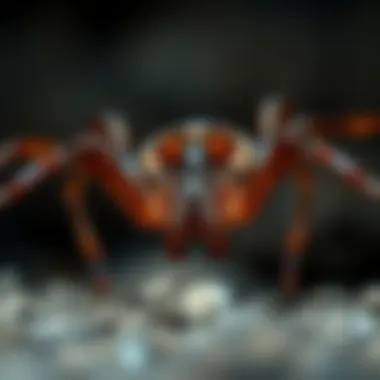
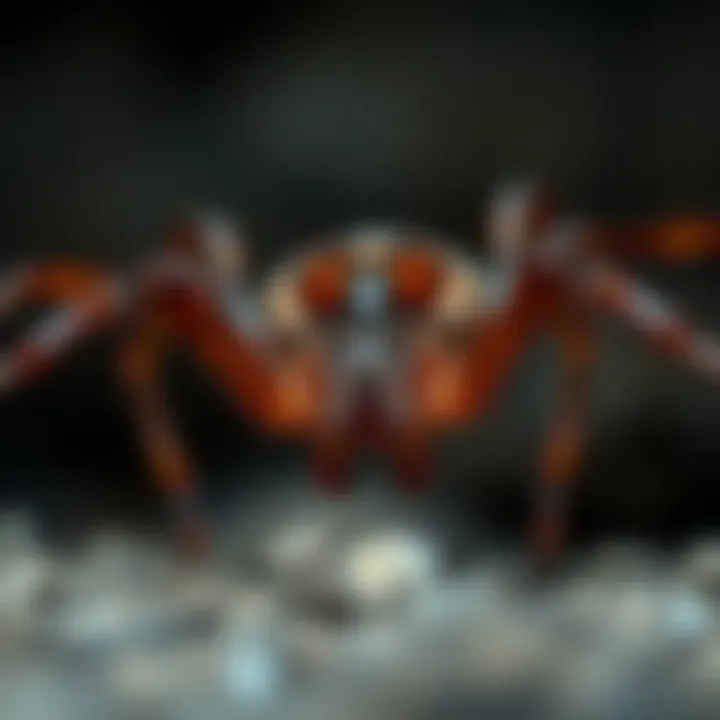
Intro
The brown recluse spider, often painted with a sinister brush in popular media, sparks a blend of curiosity and fear. Discerning the fact from fiction surrounding this arachnid is essential for a well-informed public. This article seeks to navigate through the biological tapestry of the brown recluse, unraveling its behaviors, habitats, and roles within ecosystems.
Often lingering in the corners of basements and attics, Loxosceles reclusa, as it is scientifically named, plays a surprisingly beneficial role in controlling pest populations. However, misconceptions about its venomous bite have created an aura of misunderstanding that needs addressing.
In the coming segments, we will break down what makes this spider tick—examining its physical traits, dietary habits, and potential health risks related to its bite. Additionally, we will delve into ways to identify the brown recluse effectively and consider its conservation status in a rapidly changing ecological landscape.
Through a careful exploration, we aim to foster a greater appreciation for this misunderstood creature, shedding light on its unique role in our world and encouraging educated interactions.
Insights gained from studying this spider can inform not only arachnologists and biologists but also homeowners, educators, and anyone interested in nature's intricate web.
Preamble to the Brown Recluse Spider
When diving into the realm of arachnids, few species elicit as much intrigue and caution as the brown recluse spider. Understanding this creature is fundamental, not just for the sake of knowledge but also for the safety and well-being of individuals who may encounter it. This section aims to put the spotlight on the significance of the brown recluse spider, shedding light on its biological features, behaviors, and relevance in its ecosystem.
Understanding Arachnids
Arachnids, the fascinating group that includes spiders, scorpions, and ticks, play a critical role in our environment. Defined by their eight legs and a body divided into two segments, arachnids are more than just creepy-crawlies. They serve various purposes—from controlling pest populations to recycling nutrients back into the ecosystem. In the case of the brown recluse spider, their nocturnal habits ensure they are often out of sight, yet their presence is integral to maintaining a balanced ecosystem. Understanding these creatures requires a closer examination of their physiological and ecological significance.
Brown recluse spiders belong to the Sicariidae family, a less prominent but essential aspect of arachnology. Give a thought to how many other species share the same habitat; each plays its own part in the web of life, and the brown recluse contributes uniquely. Its role as both predator and prey helps define the local ecosystem, influencing the distribution of other organisms.
The Brown Recluse Spider: Overview
The brown recluse spider, scientifically named Loxosceles reclusa, is distinctly known for its violin-shaped marking on its back and its characteristic brown color. With a body length averaging between 6 to 20 mm, these spiders tend to prefer dark and secluded spaces, making them excellent at staying hidden. They favor wooden structures or cluttered areas where they can weave their webs undisturbed.
While its appearance might suggest a serene creature, the brown recluse spider has garnered a somewhat notorious reputation due to the effects of its bite. Understanding this duality—its quiet existence paired with the potential health risks—makes studying this spider both challenging and essential.
In educational settings, whether it be for students, researchers, or industry professionals, an in-depth understanding of the brown recluse spider enhances our awareness and respect for biodiversity. By focusing on their biological traits, behavior, and ecological roles, we can foster informed interactions and reduce fear-based myths surrounding these misunderstood creatures.
“The only thing we have to fear is fear itself.”
In summary, the introduction to the brown recluse spider lays the groundwork for comprehending its biological and ecological presence. This exploration fosters an educated perspective that is vital for anyone engaging with or studying arachnids.
Taxonomy and Classification
The taxonomy and classification of the brown recluse spider is more than a mere academic exercise; it is foundational to understanding its biology and ecological role. Taxonomy allows us to systematically categorize the myriad species within the arachnid class, showcasing their relationships, evolutionary histories, and distinguishing characteristics. This framework not only aids researchers and professionals in identifying species but also informs conservation efforts by highlighting phylogenetic ties among organisms. By delving into the brown recluse's classification, we can better appreciate its place within the rich tapestry of spider diversity.
Taxonomic Hierarchy
The taxonomic hierarchy of the brown recluse spider can be described as follows:
- Kingdom: Animalia
- Phylum: Arthropoda
- Class: Arachnida
- Order: Araneae
- Family: Sicariidae
- Genus: Loxosceles
- Species: Loxosceles reclusa
Each level of this hierarchy informs us about the shared features and distinctions that define this spider. The family Sicariidae, for instance, is particularly noted for its venomous members, and the genus Loxosceles highlights the unique traits that differentiate the brown recluse from other spiders. Understanding this hierarchy is critical, as it underpins studies in ecology, behavior, and species conservation. One can imagine the hierarchical structure as a family tree, where each branch signifies a shared lineage, facilitating a deeper connection and understanding of related species.
Related Species
While the brown recluse remains a notable representative of the Sicariidae family, it is essential to recognize the related species that share its general characteristics and ecological niches:
- Sicarius spp.: Commonly known as six-eyed sand spiders, these spiders have similar venom characteristics and inhabit sandy environments.
- Loxosceles spp.: Other species like the Chilean recluse and the Mediterranean recluse pose similar health risks due to their venom but are geographically distinct.
The similarities amongst these species have allowed researchers to investigate potential overlaps in habitat preference, diet, and interactions within ecosystems. Such studies contribute to a more comprehensive understanding of how species adapt and thrive in their environments. Furthermore, comparing the brown recluse with its kin can debunk various myths regarding its classification and toxicity, clarifying the dangers these spiders might pose in human-dominated areas.
In sum, the taxonomy and classification of the brown recluse spider serve as a crucial narrative to its biological identity and ecological significance. Through taxonomy, we can draw connections, clarify misconceptions, and promote informed discussions around one of nature's most misunderstood creatures.
Physical Characteristics
The physical attributes of the brown recluse spider are crucial for a proper understanding, especially for those looking to identify this often-misunderstood arachnid. Recognizing its characteristics can aid in distinguishing it from other species, which is essential for safety and ecological appreciation. Within this section, we will explore its distinctive features and the morphological adaptations that make the brown recluse unique.
Distinctive Features
Coloration
Coloration plays a significant role in identifying the brown recluse spider. Typically, this spider showcases a tan to yellow-brown hue. This choice of color isn't merely aesthetic; it serves as an effective camouflage against natural substrates, like soil and wood, helping it elude predators. The pivotal aspect of its coloration is the dark violin-shaped marking on its back, which is a defining characteristic. This can be particularly helpful when one is trying to distinguish it from non-venomous lookalikes.
Being able to identify this coloration can prevent unnecessary panic; having this knowledge equips individuals to understand the spider’s behavior better and acknowledge its importance in the ecosystem.
Size
Size is another defining feature when it comes to the brown recluse. Adult spiders typically measure between 6 to 20 millimeters, excluding their leg span, which can be much larger. The compact body gives them a discreet profile, aiding in their survival. The size of the brown recluse is beneficial in terms of adaptability; it allows them to navigate through small crevices and remain undetected by potential threats.
When discussing size, it’s crucial to point out that while the brown recluse might seem menacingly large to some, its size is relatively small compared to many other spider species. Understanding this context can help demystify the fear surrounding these creatures.
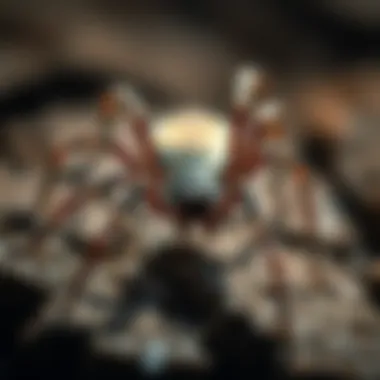
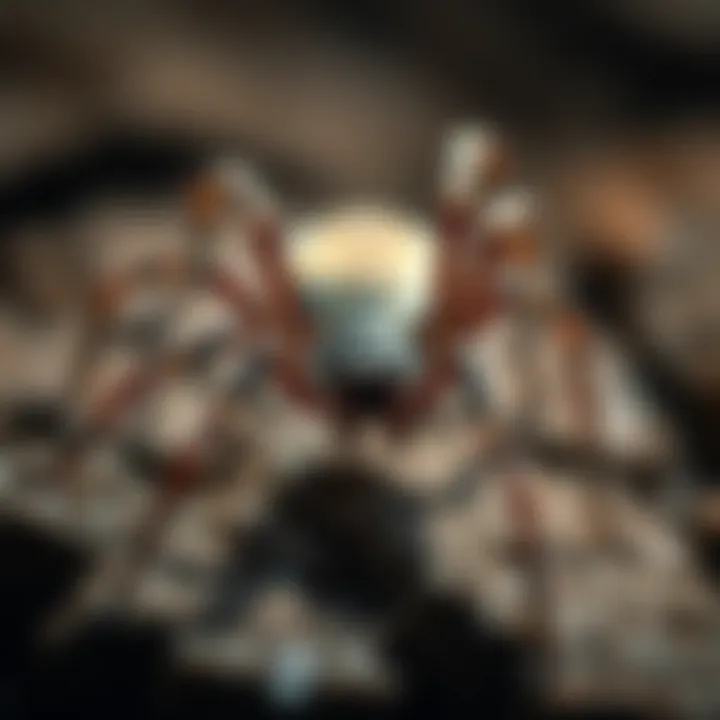
Eye Arrangement
The eye arrangement of the brown recluse spider is quite unique and serves as an important identifying feature. Unlike many other spiders that possess eight eyes arranged in pairs, the brown recluse has six eyes arranged in three pairs. This distinctive layout, especially when noted in combination with its coloration and size, provides a reliable clue for identification.
Such an arrangement aids in depth perception, which is essential for hunting. However, for those unfamiliar with spiders, this trait can be misleading. Many might overlook it, which could lead to misidentifying the spider and hence, misunderstanding its role in the environment.
Morphological Adaptations
Morphological adaptations refer to the physical changes and features that enhance the spider's ability to survive and thrive in its habitat. The brown recluse has adapted to thrive in dry, secluded spaces, such as attics and basements. One example is its long, slender legs, which facilitate navigation through tight spaces. This feature allows the spider to hunt effectively for insects whilst avoiding larger predators.
Furthermore, their ability to blend into their environment is formidable. The specific traits of the brown recluse—color, size, and eye arrangement—combine to create a creature often overlooked yet crucial to maintaining the ecological balance. Understanding these aspects is vital for anyone studying the species in-depth, as it opens the door to recognizing the brown recluse not just as a potential health risk, but also as a significant ecological player.
Understanding the physical traits of the brown recluse spider is fundamental not only for safe interaction but also for appreciating its role in the ecosystem.
In summary, the physical characteristics of the brown recluse spider contribute greatly to its ability to blend into its surroundings and survive in varied conditions. They showcase how evolution and adaptation play crucial roles in the survival of this species.
Behavioral Patterns
Understanding the behavioral patterns of the brown recluse spider is essential for several reasons. It gives insights into how this species interacts with its environment, manages threats, and reproduces. Such knowledge can inform safety protocols and enhance our comprehension of arachnid ecology. These spiders aren’t just idle creatures lurking in dark corners; they have specific habits that support their role within their habitats.
Feeding Behavior
Diet
The diet of the brown recluse spider primarily consists of soft-bodied insects. Common prey includes crickets, moths, and cockroaches. This specific choice of diet plays a crucial role in the spider's survival as it directly impacts its growth and reproductive success. By consuming these insects, the brown recluse helps regulate pest populations around human habitats, demonstrating its ecological importance.
One key characteristic of the brown recluse's diet is its preference for live, active prey rather than scavenging on dead insects. This hunting behavior allows the spider to consume fresh protein, which is vital for tissue repair and energy. On the downside, the need to hunt live insects means that the spider must be adept at locating and capturing these creatures, which adds to its vulnerability if prey is scarce.
Unique Feature: The brown recluse has developed a specialized feeding technique where it injects venom into its prey to immobilize it before consumption. Venom not only aids in subduing the prey but also begins the digestion process, making it easier for the spider to extract nutrients. The advantage of such a method ensures that energy expenditure remains efficient, especially in environments where food becomes a limiting factor.
Hunting Techniques
The hunting techniques employed by the brown recluse are fascinating and demonstrate its adaptability. This spider doesn’t weave webs to capture prey, which is quite unique among spiders. Instead, it adopts a more active hunting strategy known as 'sit-and-wait' or ambush. It lies in wait until potential prey comes too close, relying on its color to blend with its environment for camouflage.
The key advantage of this method is efficiency. Since the brown recluse typically hunts at night, it conserves energy during the day and exploits the nighttime when their prey is most active. However, the passive nature of sitting and waiting can backfire if the spider finds itself in a competition-rich environment, where more aggressive predators can outcompete it for food.
Unique Feature: Another interesting aspect of their hunting technique is the ability to detect vibrations, which signals the presence of movement nearby. This sensitivity can alert them of potential prey or even threats, contributing to their survival. The downside? If prey is not attentive, the spider might miss out on critical hunting opportunities, especially in cluttered environments.
Reproductive Behavior
Reproductive behavior in the brown recluse is another critical area of interest. The mating rituals can be complex and are crucial for the continuation of the species. These spiders engage in courtship displays to attract mates, wherein males may perform specific movements or vibrational signals to indicate their presence. Understanding this behavior provides insight into their breeding patterns, which in turn sheds light on population dynamics and genetic diversity within the species.
These behaviors highlight the intricacies of spider life that are often overlooked. Insights into their feeding and reproductive habits can foster a deeper appreciation for these creatures and encourage responsible coexistence with them in our environments.
Habitat and Distribution
Understanding the habitat and distribution of the brown recluse spider is crucial for comprehending its ecological role and the potential risks it poses to humans. This section unpacks the environments where these spiders thrive, how they interact with their surroundings, and the implications of their geographical spread. Identifying their preferred habitats not only helps in guiding avoidance strategies but also informs conservation efforts aimed at balancing human needs and arachnid survival.
Preferred Habitats
The brown recluse spider typically prefers warm, dry environments. It often inhabits undisturbed areas such as:
- Basements & Attics: These spaces provide a safe refuge, away from the prying eyes of humans and predators alike.
- Wood Piles: A favorite spot for these spiders, as wood piles offer both shelter and plenty of hiding spots.
- Closets: Dark and quiet, closets offer excellent breeding grounds.
Brown recluse spiders often evade notice due to their coloring and behavior. They tend to stay hidden in crevices or beneath debris, only coming out at night to hunt. This nocturnal activity plays a pivotal role in their survival.
Notably, the brown recluse thrives in areas that tend to be arid. They are primarily found in the central and southern parts of the United States, where warmer climates prevail. In terms of building habits, they are less likely to wander into heavily trafficked areas like supermarkets or parks, focusing instead on spaces that offer both shade and seclusion.
Geographical Range
The brown recluse spider's geographical range predominantly spans across the United States, extending from the southern reaches up through parts of the Midwest. States such as:
- Kentucky
- Tennessee
- Arkansas
These regions not only provide the environmental conditions conducive to their survival but also contain the territory that leads to occasional encounters with humans. There are even reports of the brown recluse making its home in more temperate zones, where conditions allow for reasonable insulation against cold winters.
Interestingly, while they are primarily identified in the United States, sightings in parts of Central and South America have led researchers to consider whether their range might expand over time due to climate changes.
"The brown recluse showcases an intricate relationship with its environment, balancing its need for shelter with the risks imposed by human interaction."
In summary, knowledge about the brown recluse spider's habitat and distribution is vital not just for understanding the spider itself, but for discussing biodiversity, conservation efforts, and mitigating health risks associated with accidental encounters.
Health Risks Associated with the Brown Recluse
When discussing the brown recluse spider, understanding health risks is crucial, especially given the creature's notoriety in popular culture. This section covers the potential dangers that may arise from a bite by this shy arachnid, focusing on the biological implications of its venom as well as the symptoms and recommended medical responses. By being informed about its health risks, readers can better appreciate and navigate the challenges associated with encounters with this spider.
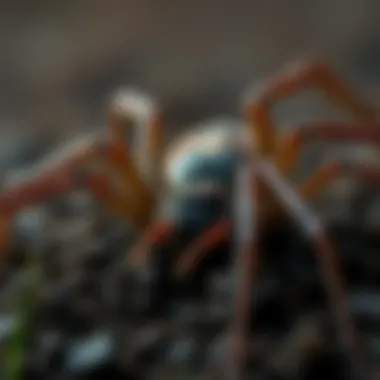
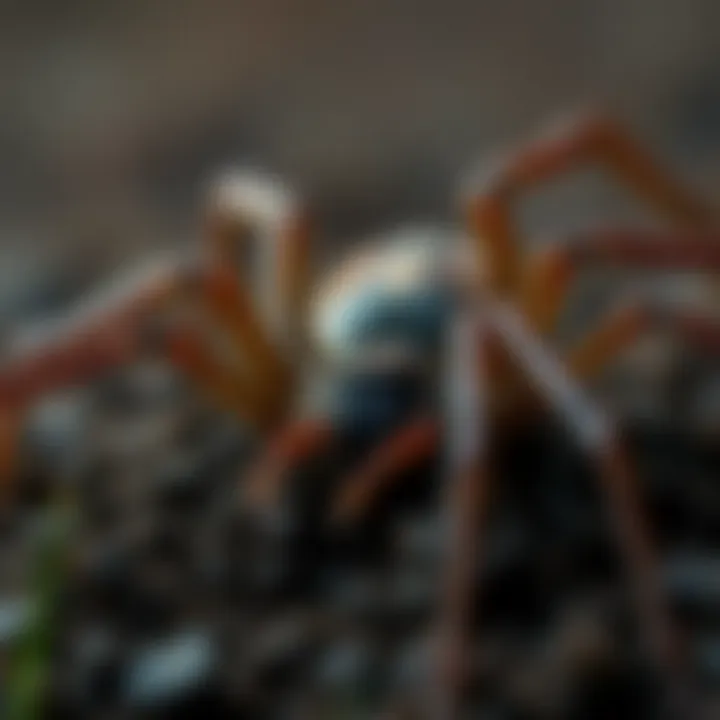
Toxicity of the Bite
The bite of the brown recluse spider harbors a significant degree of toxicity, primarily due to the presence of a potent venom called sphingomyelinase D. This venom works by disrupting cellular membranes and can lead to various local and systemic effects. Understanding the toxicity of the bite not only helps in recognizing the severity of potential envenomations but also emphasizes the need for timely medical intervention.
A pivotal element of the bite's toxicity is the likelihood for necrosis, which can develop in the tissues surrounding the bite area. This unique feature highlights the importance of observing reactions post-bite as it can inform necessary medical responses.
Symptoms of Envenomation
Recognizing the symptoms of envenomation is essential for anyone at risk of a brown recluse bite. Symptoms can be categorized into local reactions and systemic effects, each contributing differently to the overall health risks associated with this spider.
Local Reactions
Local reactions include immediate pain and swelling at the bite site, which may escalate into more severe complications like redness and necrosis. The key characteristic of local reactions is that they often appear within a few hours of the bite, making it easier for individuals to connect their symptoms to the encounter. This can be beneficial, as awareness allows for quicker action, potentially mitigating further damage.
One unique feature of local reactions is the formation of a blister that can be surrounded by a ring of redness and swelling, serving as a visual cue for medical professionals during assessment. The advantages of recognizing local reactions lie in the opportunity for early medical intervention, which may prevent more severe tissue damage. Conversely, a disadvantage includes the potential for misdiagnosis as similar symptoms can arise from bites of other spiders or insects.
Systemic Effects
Systemic effects occur when venom spreads through the bloodstream, impacting various body systems. Symptoms may include fever, chills, and sometimes severe muscle pain, which can further complicate the diagnostic process. One of the prominent characteristics of systemic effects is that they often arise days following the initial bite, which poses a challenge for accurate diagnosis.
The systemic effects can have extensive implications for a person’s health, emphasizing the need for vigilance and comprehensive medical evaluation. A unique aspect of these effects is their potential to lead to conditions such as hemolysis and renal failure in severe cases, representing a significant health risk. While these consequences underscore the seriousness of a brown recluse bite, the advantage lies in the establishment of guidelines for medical response and treatment protocols, aiding professionals in managing such complex cases.
Medical Responses
Immediate medical response to a brown recluse spider bite is critical. Upon experiencing symptoms, individuals should seek medical attention without delay. Several approaches can be taken in response to a bite:
- Wound Care: Cleaning the bite site thoroughly to prevent infection and monitoring for any signs of necrosis.
- Pain Management: Administering pain relief medications to help alleviate discomfort.
- Observation: In cases where systemic effects develop, patients may require hospitalization for monitoring and further treatment.
Education on the appropriate medical responses can help reduce the risks associated with these bites. By understanding the nature and scope of the health risks involved, individuals can respond effectively and improve their overall outcomes. Educating oneself about the brown recluse spider, its potential hazards, and necessary responses can dramatically enhance public safety and health.
For further details on bite management and treatment, resources such as the Centers for Disease Control and Prevention or medical literature can provide reliable guidance.
Identification Techniques
Understanding how to identify the brown recluse spider is crucial for anyone studying this species or interacting with its environment. Misidentification could lead to unnecessary anxiety or mishandling, particularly given the health risks associated with its bite. By utilizing distinct identification techniques, individuals can gain better insights into the spider’s characteristics, behaviors, and crucial roles within its ecosystem. This section covers various methods of visual identification and the significance of specific identifying marks that distinguish the brown recluse from similar-looking spiders.
Visual Identification
Visual identification serves as the first line of defense in recognizing a brown recluse spider. This species exhibits several identifiable characteristics such as color, size, and eye arrangement. Noting these details can prevent confusion with other non-threatening arachnids.
- Coloration: Typically, the brown recluse has a light to dark brown hue, with a somewhat dull appearance. Slightly shiny or glossy features are not typical of this species. Recognizing such tonality can help distinguish it from more vibrant spiders.
- Size: Adult brown recluses generally measure between 6 to 20 mm in body length, making them noticeably smaller than many other tarantulas and larger species.
- Eye Arrangement: A standout feature of the brown recluse is its unique eye arrangement. Most spiders have eight eyes arranged in pairs, whereas the brown recluse has six eyes, arranged in a distinctive pattern. This sets them apart visually.
Using Identifying Marks
Features like the violin pattern and color variations are invaluable in identifying the brown recluse spider. They offer visual clues that can aid in proper identification, thus ensuring a safer interaction with this arachnid.
Violin Pattern
The violin pattern on the back of a brown recluse spider is one of its most telling characteristics. As the name suggests, this mark resembles the shape of a violin, which typically features a darker, somewhat raised mark that extends backward towards the abdomen. This visual cue is particularly beneficial for recognition, as it is often the first detail noted during identification.
- Key Characteristic: The violin shape can vary but remains a reliable indicator when spotted.
- Benefits: Utilizing this pattern for identification is effective because it distinguishes brown recluses from many harmless spiders that lack such distinctive markings.
- Unique Feature: However, variations do exist. Some individuals may have less pronounced violin shapes which could lead to misidentification.
Color Variations
Color can also play a significant role in identifying the brown recluse spider. Within this species, various shades can occur based on environmental conditions, health, and habitat. These variations range from golden-tan to deep brown, and some even possess slightly ashen tones.
- Key Characteristic: Varied colorations offer flexibility in identifying these spiders, making it possible to spot them across different environments.
- Benefits: Understanding these variations amplifies the identification skills necessary for accurately classifying the brown recluse among other common household spiders.
- Unique Feature: Yet, this could create challenges; light conditions and surrounding backgrounds can warp how these colors appear, complicating identification.
Conservation Status
Conservation status refers to the condition of a species with respect to its abundance and survival in its natural habitat. Understanding the conservation status of the brown recluse spider is crucial for several reasons. First, awareness about its population dynamics helps researchers and conservationists to identify potential threats. Moreover, it highlights the significance of ecological roles played by various species, including those that may seem less critical at a glance, such as the brown recluse. Recognizing these factors can lead to more effective conservation strategies.
Threats to Population
The brown recluse spider faces a myriad of threats that can significantly affect its population. Some of the most notable threats include:
- Habitat loss: Urban expansion and land development often strip natural habitats, pushing spiders into fragmented areas where survival is compromised.
- Pesticide use: Chemicals designed to control pest populations are indiscriminate and can harm non-target arachnids, including the brown recluse.
- Climate change: Fluctuating temperatures and altered weather patterns can disrupt breeding cycles and food availability, impacting overall spider health and numbers.
The interplay of these threats leads to increasing vulnerability. Indeed, the declining numbers may result in ecological imbalances, where the roles of such predators in controlling pest insects are diminished.
The decline of any species can ripple through ecosystems, causing unforeseen consequences.
Conservation Efforts
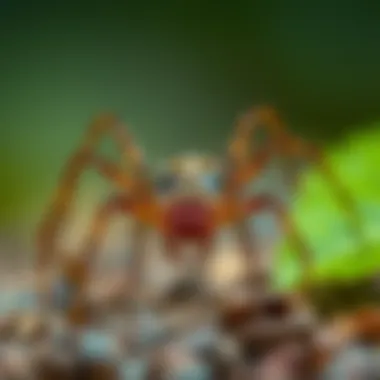
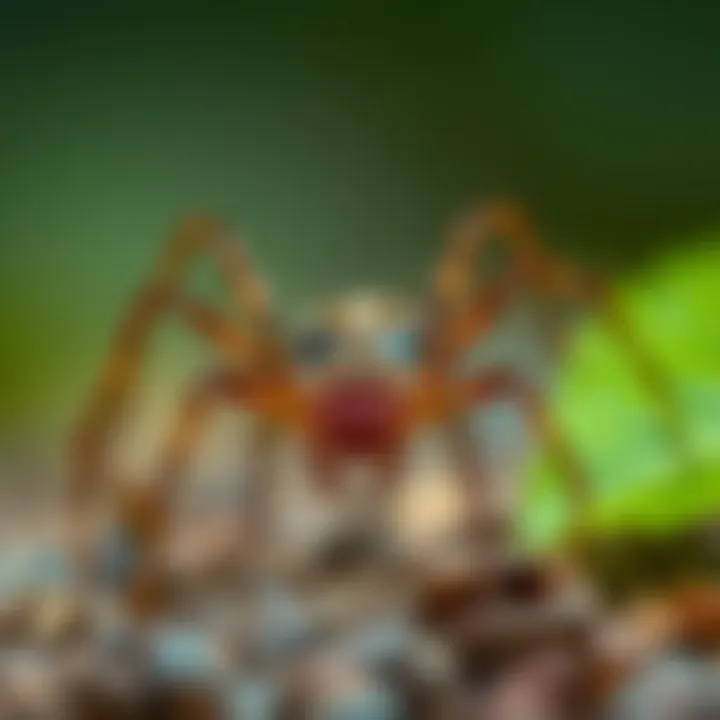
Efforts to conserve the brown recluse spider can be categorized into various strategies:
- Habitat Preservation: Protecting natural habitats and restoring areas that have been degraded is paramount. This may involve establishing legal protections for areas critical to spider populations.
- Public Awareness Campaigns: Educating the public on the ecological importance of spiders can mitigate fear-driven killing and spark interest in conservation.
- Research and Monitoring: Ongoing studies to track population changes and health are vital. Collaborations between universities and conservation groups can lead to meaningful insights into the species’ ecology.
Ultimately, conservation of the brown recluse does not solely benefit the spider itself, but promotes overall ecological health, which is necessary for sustaining biodiversity.
The Brown Recluse within Ecosystems
The brown recluse spider plays a significant role in its ecosystem, which goes beyond its often negative reputation. Understanding its ecological importance sheds light on the interdependence of species and the delicate balance maintained in nature. This section explores how the brown recluse spider contributes to pest control and how its interactions with other species illustrate its integral role in ecosystems.
Role in Pest Control
The brown recluse, as an adept hunter, directly impacts pest populations. By preying upon various insects, it helps maintain a balanced ecosystem. This natural pest control is crucial, especially in areas where insect populations may escalate unchecked. A single brown recluse can consume a substantial quantity of insects like flies, cockroaches, and other household pests over its lifetime.
- Key Characteristics: The brown recluse is a solitary spider, often found in undisturbed areas, which allows it to effectively control pest populations without much human interference.
- Benefits: This pest management is advantageous for homeowners and gardeners alike, providing a natural solution to controlling pests that can harm crops or spread disease.
Understanding the predatory behavior of the brown recluse encourages a more nuanced view of its role—far from being a mindless menace, it helps keep the populations of more harmful insects in check.
Interactions with Other Species
Interactions with other species paint a detailed picture of the ecological niche occupied by the brown recluse. These interactions span both predator and prey relationships, highlighting the spider's dynamic role in its habitat.
Predators
The brown recluse is not without its own threats; it has various natural predators that influence its population dynamics. Birds, particularly those that feed on spiders, are among its primary predators. This relationship exemplifies the food web where each species has a place and purpose.
- Characteristics of Predators: Avian predators often rely on their keen eyesight, agile flight, and adaptability to hunt brown recluses in their preferred habitats. These birds' hunting capabilities are sophisticated and play a crucial part in regulating spider populations.
- Unique Features: Many birds have learned specific hunting techniques, like perching near spider habitats and waiting for the right moment to strike. Their presence can lessen the numbers of brown recluses, ensuring that their population does not grow too large, which would disrupt local ecosystems.
Thus, these predator-prey interactions not only help keep the spider population in check but also add to the complexity of ecological relationships.
Prey
On the opposite side, brown recluses primarily feed on soft-bodied insects. Their diet typically includes small insects such as crickets and moths, which are plentiful in their environments.
- Key Characteristics of Prey: Their prey often include various beetles and other garden pests that can become invasive. By keeping these populations under control, the brown recluse contributes to the health of the ecosystem.
- Advantages of Prey: Such feeding habits highlight the brown recluse's role as both predator and prey within its habitat. It’s vital for maintaining a natural balance—if a spider consumes too many pests, it can negatively affect the local insect population, swinging the balance too far in one direction.
In summary, the brown recluse spider is an integral part of its ecosystem, influencing both pest control and interactions with other species. By considering these factors, we gain a richer understanding of the ecological webs that sustain life in diverse environments.
"Understanding the ecological role of the brown recluse can shift perceptions from fear to appreciation for its contributions to pest management."
For a deeper exploration of the ecological roles of arachnids, you can visit Britannica or check more about spiders on Wikipedia.
Learn more about specific pest control methods that include the brown recluse at various educational sites or local university entomology pages. Understanding these roles not only enhances our comprehension of biodiversity but also informs how we coexist with these fascinating creatures.
Myths and Misunderstandings
The topic of myths and misunderstandings surrounding the brown recluse spider is critical in shaping public perception and response to this often-feared arachnid. As many who encounter this creature might have heard tall tales or exaggerated claims about it, addressing these misconceptions provides an opportunity to dispel unnecessary fears and enhance our understanding of its ecological role. The significance of this section cannot be overstated; awareness fosters informed decisions regarding human-animal interactions and mitigates irrational reactions that benefit neither humans nor spiders. By clarifying these myths, we can cultivate a more nuanced understanding of the brown recluse's behaviors, risks, and population dynamics.
Common Misconceptions
Many misconceptions about the brown recluse spider stem from a lack of knowledge or a knee-jerk reaction to the word "spider." One prevalent myth claims that all brown spiders are potentially dangerous. In reality, the brown recluse has specific defining features that help differentiate it from harmless relatives, such as the common house spider. Another common belief is that these spiders are aggressive and will actively seek out human confrontation. This is far from true; like other reclusive creatures, brown recluses prefer to avoid humans and will bite only when they feel threatened. There are also exaggerated narratives about the severity of its bite, leading people to think that every bite leads to dire consequences. While some reactions can be serious, many are mild and manageable, often confused with bites from other species or allergic reactions.
Reality vs. Myth
When assessing the reality behind the myths, it is essential to rely on scientific findings rather than folklore. >"Understanding the truth about the brown recluse can help alleviate unfounded fears and empower individuals to coexist with these spiders more harmoniously."
Research has shown that, in most cases, the bite of a brown recluse does not cause significant harm. Symptoms can range from mild irritation to more severe effects, but the latter is often linked to individual health factors, such as allergic responses or infections rather than the inherent danger of the spider itself. Moreover, the presence of the distinctive violin shape on its back is a reliable identifier, aiding in proper identification.
Summary of Common Myths
- Myth: All brown spiders will bite and cause serious harm.
Reality: Only the brown recluse has venom potent enough to cause reactions; identification is key. - Myth: Brown recluses aggressively attack humans.
Reality: They are shy and tend to flee when confronted.
By clarifying these points, we can effectively address the misconceptions that cloud the public’s understanding of brown recluse spiders.
For further reading on the taxonomy and behaviors of the brown recluse spider, you can visit reputable resources like Britannica or Wikipedia. To explore experiences and discussions around spider interactions, Reddit can offer various insights: Reddit.
Additionally, educational domains such as *.edu may provide scientific studies that shed light on arachnid behavior and human interactions.
Ending
In closing, understanding the brown recluse spider is crucial for both scientific inquiry and public safety. This species, often surrounded by myth and fear, plays a significant role in ecosystems yet poses health risks that must be taken seriously. A well-rounded knowledge of its biology, behavior, and habitats helps demystify the brown recluse, allowing people to approach arachnids with informed caution rather than blind terror. By shining a light on this often-misunderstood creature, we foster a better understanding of the natural world, where even the smallest beings hold importance.
Summary of Key Points
- Biology and Behavior: Delving into the physical characteristics of the brown recluse reveals its notable features, such as size and distinctive markings. Understanding its behavioral tendencies, like how it hunts or reproduces, is essential for grasping its ecological role.
- Health Risks: While fears surrounding its bite are prevalent, the actual risk and symptoms are often exaggerated. Knowing the facts can alleviate undue worry while emphasizing the need for prompt medical attention when bites occur.
- Conservation and Ecology: The brown recluse is not just a menace. It contributes to natural pest control and interacts with various species within its habitat. Conservation efforts can help maintain balance within its ecosystem.
- Myths vs. Reality: A critical examination of myths helps clarify misconceptions, allowing for a more accurate representation of the spider in public discourse.
Future Research Directions
As research continues, several intriguing avenues present themselves for further exploration:
- Habitat Specificity: Investigating how urbanization and habitat loss impact the distribution of brown recluse populations can provide insight into broader ecological consequences.
- Bite Mechanism and Effects: Detailed studies on the physiological mechanisms of the brown recluse's venom could lead to advancements in medical treatment and understanding of envenomation effects.
- Interactions with Other Species: Further observation on how the presence of brown recluse spiders affects other species within their ecosystem can shed light on their role as both predator and prey.
- Public Awareness Campaigns: Future studies could focus on the effectiveness of educational programs aimed at dispelling myths associated with this spider, ultimately reducing unnecessary fear.
By pursuing these directions, researchers can further enrich the discourse on the brown recluse spider, shaping perceptions, and influencing conservation strategies.















